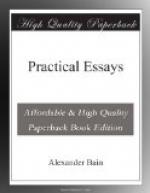A more notable example is the doctrine of the alliance of Mind with Matter. It is impossible that any mode of viewing this alliance can erase the distinction between the two modes of existence—the material and the mental; between extended inert bodies, on the one hand, and pleasures and pains, thoughts and volitions, on the other. Yet, after the world has been made familiar with the Cartesian doctrine of two distinct substances—the one for the inherence of material facts, and the other for mental facts—any thinker maintaining the separate mental substance to be unproved, and unnecessary, is denounced as trying to blot out our mental existence, and to resolve us into watches, steam-engines, or speaking and calculating machines. The upholder of the single substance has to spend himself in protestations that he is not denying the existence of the fact, or the phenomena called mind, but is merely challenging an arbitrary and unfounded hypothesis for representing that fact.
[PERCEPTION OF A MATERIAL WORLD.]
The still greater controversy—distinct from the foregoing, although often confounded with it—relating to the Perception of a Material World, is the crowning instance of the weakness we are considering. Berkeley has been unceasingly stigmatised as holding that there is no material world, merely because he exposed a self-contradiction in the mode of viewing it, common to the vulgar and to philosophers, and suggested a mode of escaping the contradiction by an altered rendering of the facts. The case is very peculiar. The received and self-contradictory view is exceedingly simple and intelligible in its statement; it is well adapted, not merely for all the commoner purposes of life, but even for most scientific purposes. The supposition of an independent material world, and an independent mental world, created apart, and coming into mutual contact—the one the objects perceived, and the other the mind perceiving—expresses (or over-expresses) the division of the sciences into sciences of matter and sciences of mind; and the highest laws of the material world at least are in no respect falsified by it. On the other hand, any attempt to state the facts of the outer world on Berkeley’s plan, or on any plan that avoids the self-contradiction, is most cumbrous and unmanageable. A smaller, but exactly parallel instance of the situation is familiar to us. The daily circuit of the sun around the earth, supposed to be fixed, so exactly answers all the common uses that, in spite of its being




